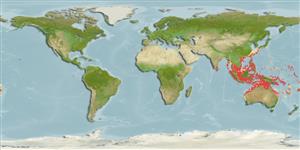Common names from other countries
>
Eupercaria/misc (Various families in series Eupercaria) >
Labridae (Wrasses)
Etymology: Xiphocheilus: Greek, xiphos = sword + Greek, cheilos = lip (Ref. 45335).
More on author: Bleeker.
Environment: milieu / climate zone / depth range / distribution range
Ecologia
marinhas; estuarina associadas(os) a recifes; intervalo de profundidade 15 - 85 m (Ref. 9823). Tropical
Western Pacific: extending into the Indian Ocean only in an area to the west of the Malay Peninsula (Ref. 9823). Recorded from North West Shelf, Australia; Indo-Australian Archipelago (Ref. 3132).
Tamanho / Peso / Idade
Maturity: Lm ? range ? - ? cm
Max length : 12.0 cm SL macho/indeterminado; (Ref. 9823)
Espinhos dorsais (total): 12; Raios dorsais (total): 8; Espinhos anais 3; Raios anais : 10
Lives on flat sandy bottoms or rubble (Ref. 3132). Often taken by trawlers but still occassionally seen near reefs. Found solitary or in small groups (Ref. 90102). Minimum depth reported from Ref. 90102.
Ciclo de vida ou comportamento de acasalamento
Maturidade | Reprodução | Desova | Ovos | Fecundidade | Larvas
Oviparous, distinct pairing during breeding (Ref. 205).
Westneat, M.W., 2001. Labridae. Wrasses, hogfishes, razorfishes, corises, tuskfishes. p. 3381-3467. In K.E. Carpenter and V. Niem (eds.) FAO species identification guide for fishery purposes. The living marine resources of the Western Central Pacific. Vol. 6. Bony fishes part 4 (Labridae to Latimeriidae), estuarine crocodiles. FAO, Rome. (Ref. 9823)
Status na Lista Vermelha da UICN (Ref. 130435)
Warning: mysqli::__construct(): (HY000/1040): Too many connections in /var/www/html/includes/func_getlabel.php on line 46
Can't connect to MySQL database (fbapp). Errorcode: Too many connections
